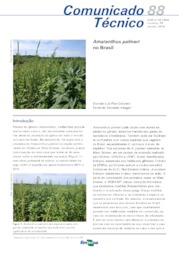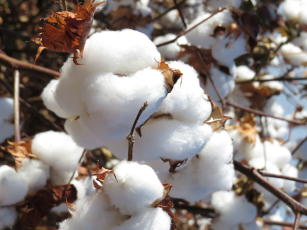Brazilian cotton shows competitiveness in American soil
Brazilian cotton shows competitiveness in American soil
Photo: Valdinei Sofiatti

Cotton plantation. The cultivars BRS 286, BRS 293, BRS 335 were evaluated in Mississippi, Tennessee and Texas.
Three conventional cotton cultivars developed by Embrapa are being tested in American plantations in the states of Mississippi, Tennessee, and Texas, and have presented high productivity and low production costs.
“The first tests demonstrated the excellent quality of Embrapa's genetics”, informs the deputy manager of Embrapa Products and Market, Rafael Vivian. “The introduction of conventional cultivars − BRS 286, BRS 293 and 335 BRS − in the United States, where 98% of the crops are the genetically modified product, is an achievement for Brazil to participate in the international market of cotton seeds”, he stresses.
The manager highlights the importance of the fact Brazil is entering that market with a non-GMO in a traditional branch of North American agriculture. “In addition to introducing Brazilian genetics in a country with a long history of cotton cropping, we are breaking through cultural barriers in the adoption of a genuinely traditional technology”, reinforces Vivian.
American farmers found the Brazilian cultivars an excellent opportunity to go back to conventional cotton cultivars, attracted by a more attractive cost-benefit ratio. The cost of sowing one hectare of genetically modified (aka transgenic) cotton is around 250 dollars per hectare. This includes a "technology fee" of US$200/ha, which represents the royalties that the seed companies charge farmers for the use of transgenics, plus the cost of the seeds, which is US$ 50/ha. “With regard to conventional (non-GM) cultivars, this cost does not reach US$ 50/ha, which is only the cost of the seeds themselves”, compares Valdinei Sofiatti, deputy head of Technology Transfer of Embrapa Cotton, the Embrapa unit responsible for the development of the Embrapa cotton cultivars.
Embrapa's conventional cotton cultivars have become an especially attractive option in the United States because genetically modified cultivars have not been offering the benefits of earlier times in terms of caterpillar and weed management. Sofiatti explains that the caterpillars are no longer a serious problem and the weed Amaranthus palmeri has become resistant to the herbicide previously used to control it, glyphosate. “Some American farmers no longer see reasons to pay so much for a technology that does not solve their more serious problems, which were efficiently controlled with transgenics before”, Sofiatti observes.
The low incidence of caterpillars in US cotton croplands is related to the eradication of another pest, the boll weevil. Once they were free of the main pests that used to assail the cultivation, farmers reduced the amount of insecticide that was applied in the plantations. As a consequence, other insect predators of caterpillars, which had been decimated by the insecticide, recovered. They now promote a natural control of the caterpillars, whose incidence remains below the level of economic damage.
“The only way of being competitive in any market is to have lower production costs”, affirms Sofiatti. He says that the benefits of GMOs are not enough to cover the cost of royalties, and thus some American cotton growers are starting to plant conventional varieties, which today are very rare in that country. “Hence the opportunity for our materials”, he adds.
Advantages for Embrapa
The insertion of Brazilian cultivars in cotton plantations of the United States will strengthen Embrapa's trademark, states Rafael Vivian, as the materials are protected on behalf of the company in that country by the United States Department of Agriculture (USDA), the agency that regulates the registration of cultivars in the United States. There will also be financial benefits, since funds will stem from the cultivars' intellectual property rights.
As an optimist, Vivian believes that, in the next few years, Embrapa's cotton will take up more and more areas, especially in Texas, the United States' main producer, with about two million hectares and an average productivity that does not surpass 1,500 kg/ha. “It is a low productivity index because it rains very little and irregularly”, he says. Even with the lack of rain, the Brazilian cultivars have a production potential that is similar to the American ones. For this reason, Vivian believes that Brazilian cultivars can shortly be a good option for commercial exploration in the states that integrate the so-called cotton belt in the United States.
Partnership makes sowing possible in the United States
Last January, Internacional Seed Tecnology (IST) and Embrapa (via Embrapa Products and Market) entered into a licensing contract for the multiplication and trade of the seeds of the cotton cultivars BRS 286, BRS 293 and BRS 335 in the American territory.
The partnership between the two companies started in July 2015, when a Technical Cooperation Agreement was drawn up with the aim of evaluating, selecting and concluding the development of Embrapa's BRS cultivars or conventional cotton lineages for registration and trade in the United States. That was how Embrapa's product was cultivated in American soil for the first time.
Translation: Mariana de Lima Medeiros
Edna Santos (MTb 01700/CE)
Embrapa Cotton
algodao.imprensa@embrapa.br
Phone number: +55 83 3182-4361
Sandra Zambudio (MTb 929/81/PR)
Secretariat of Communications
secom.imprensa@embrapa.br
Phone number: +55 61 3448-1530
Collaboration: Jurema Campos (MTb 1300/DF)
Embrapa Products and Market
produtos-e-mercado.imprensa@embrapa.br
Further information on the topic
Citizen Attention Service (SAC)
www.embrapa.br/contact-us/sac/




